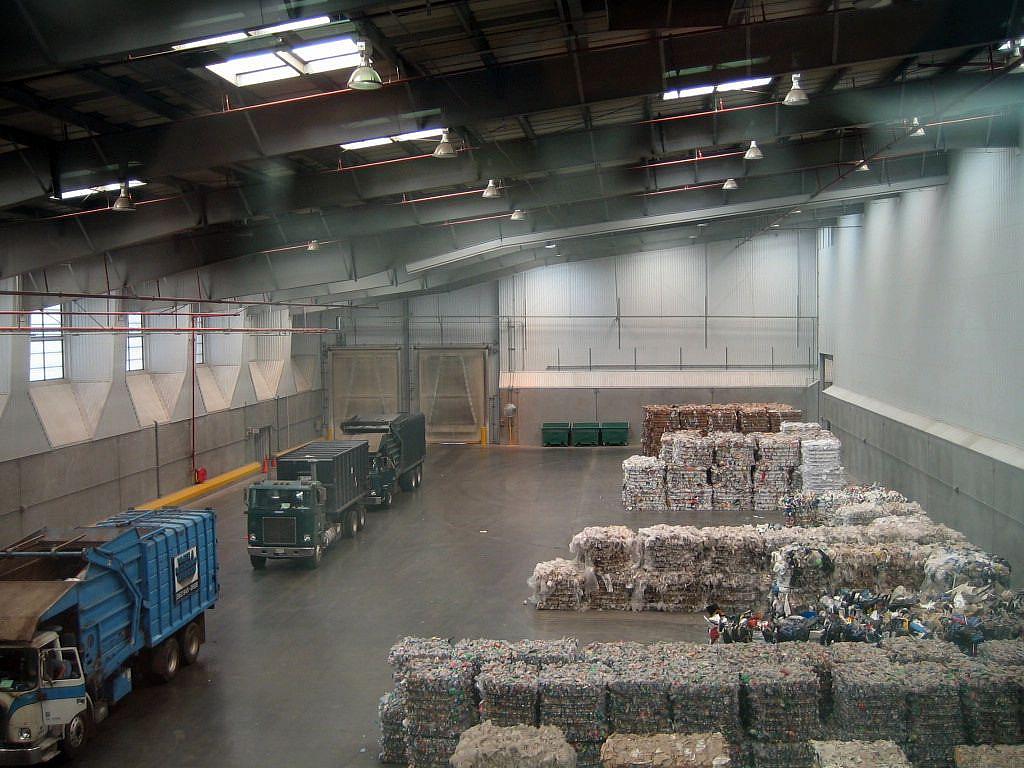Mega-landfill in the desert will welcome trash by rail
Puente Hills is the country’s largest landfill, taking in about 12,000 tons of trash daily. But if Americans are buying less stuff and recycling more, do we still need mega-landfills?
Ruxandra Guidi reported these stories for Southern California Public Radio as a 2012 California Endowment Health Journalism Fellow. Other stories in this series include:
Illegal trash dumping impacts Eastern Coachella Valley residents
Salton City landfill grows to 40 times its original size with trash from all over SoCal

Puente Hills is the country’s largest landfill, taking in about 12,000 tons of trash daily--that’s the equivalent of about 200 adult elephants, to give you an idea.
Paul Prestia, who oversees much of the operation, is watching the trucks as they flatten the incoming trash. A bunch of seagulls swoop around and dive into the piles, picking out a smelly snack. But Prestia? He’s a silver lining kind of guy. He’s just relishing the view.
“I used to work at waste-water treatment plants," he says, facing the landfill grounds and the valley below. "All waste facilities, be it landfills or power plants, all of them have great views.”
This is a state-of-the-art operation; a model for landfills worldwide. As excited as Prestia is about Puente Hills, he is even more excited about the new mega-landfill in the Imperial County town of Mesquite. Trash will continue to be brought to Puente Hills, but it will then be transported by train to Mesquite, 230 miles away.
“That’s the construction site for the new rail system," says Prestia, now leading a tour to the bottom of the man-made mountain. "The materials recovery facility is that building right here, and you can see we built our own road to go from here right to the train yard so we won’t be using local roads. Then, the trains will be loaded there and then right on to the track.”
Plans for this waste by rail system started more than 20 years ago. Every decade or so, the prospect of one of the world’s mega-cities running out of landfill space has prompted local sanitation officials to look for bold new solutions.
“Back in the 80s and 90s, because landfill capacity was a big issue and getting permits to expand landfills was always problematic, there was clearly a capacity crisis looming,” says Prestia.
In industry-speak, that’s a “garbage crisis”—one that would conjure up images of landfills filled to the brim, of trash taking over our streets, and clogging our drains. So Los Angeles looked at locations where it could dig an enormous hole in the ground. A couple of places in the desert held promise: Eagle Mountain, right next to Joshua Tree National Park; and Mesquite, about 20 miles north of the Mexico border, in Imperial—the poorest county in California.
Now, starting in 2013, LA’s trash will travel along the old Southern Pacific railway, to a 2,300-acre landfill, deep in the desert where few folks live.
“By having a regional landfill, you can locate it away from everybody," says Adrian Moore, vice president of policy at the Reason Foundation, a free-market think tank. "You can have more of a buffer around it that you can’t have in an urban area, where people want to build in every little bit of land as possible. Nobody wants to live near a landfill and now a lot fewer people do.”
But here’s the catch with the mega-landfill plan: Because of the economic downturn, people are buying less stuff and tossing less packaging. Couple that with increased recycling and we’re now producing a lot less waste—35% less, to be exact. That’s a lot of garbage that will not be heading to the desert.
Edward Humes, author of “Garbology, Our Dirty Love Affair with Trash,” says that, as a society, we’ve got it all backwards. Shouldn’t we be generating a lot less waste? And why are places like Los Angeles willing to spend three times as much to send our trash 230 miles away? Not to mention passing along the cost to taxpayers.
“The thinking now is, this is almost a white elephant!” says Humes. "The question is, are we going to have this big boondoggle in the desert or will it ultimately be useful? Or is that solution even viable anymore?”
As it turns out, the L.A. Sanitation District may have to postpone the opening date for the mega-landfill.
A better solution, Humes says, would be a lot less consumption. He points out that—despite recycling efforts--we still send almost 70% of our trash straight to landfills. And every year we throw out a collective 19 billion pounds of Styrofoam peanuts. By the way, those things never degrade and can’t be recycled.
But here’s the promising thing about trash: we’re producing a lot less, and, with the right mix of policies and incentives, we can even start using it to produce clean energy.
Back in the Eighties, L.A. Sanitation District pursued two different sites for its mega-landfill in the desert. One, at Mesquite in Imperial County. The other, Eagle Mountain, was to be located on the edge of Joshua Tree National Park. Donna Charpied and her husband, Larry, fought efforts to establish the Eagle Mountain Landfill for 23 years, all the way to the Supreme Court. The landfill would have been the largest in the country, occupying 4,654 acres of land in an area that was once an open-pit iron ore mine. Ruxandra Guidi visited Donna Charpied at her home in Desert Center, 175 miles from Los Angeles.
This article was originally published on Southern California Public Radio.
Photo credit: Heidi De Vries via Flickr
